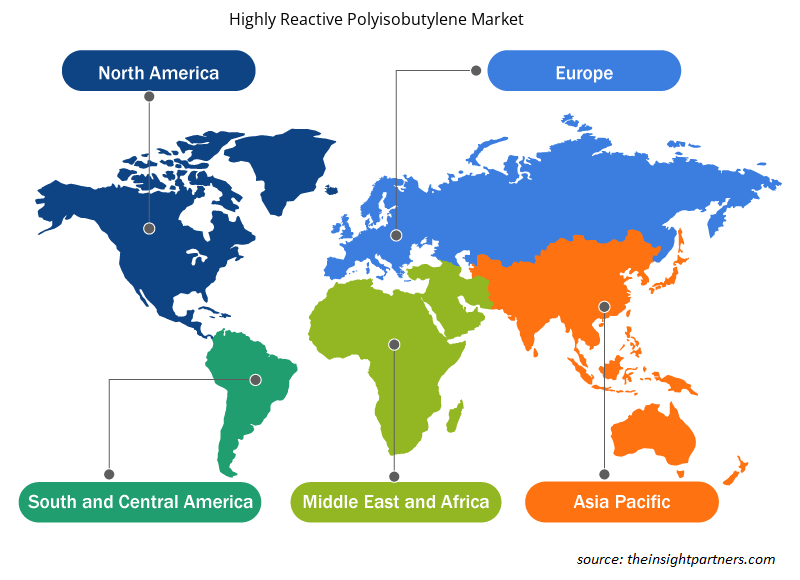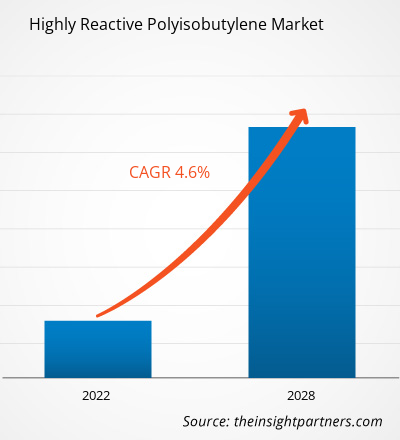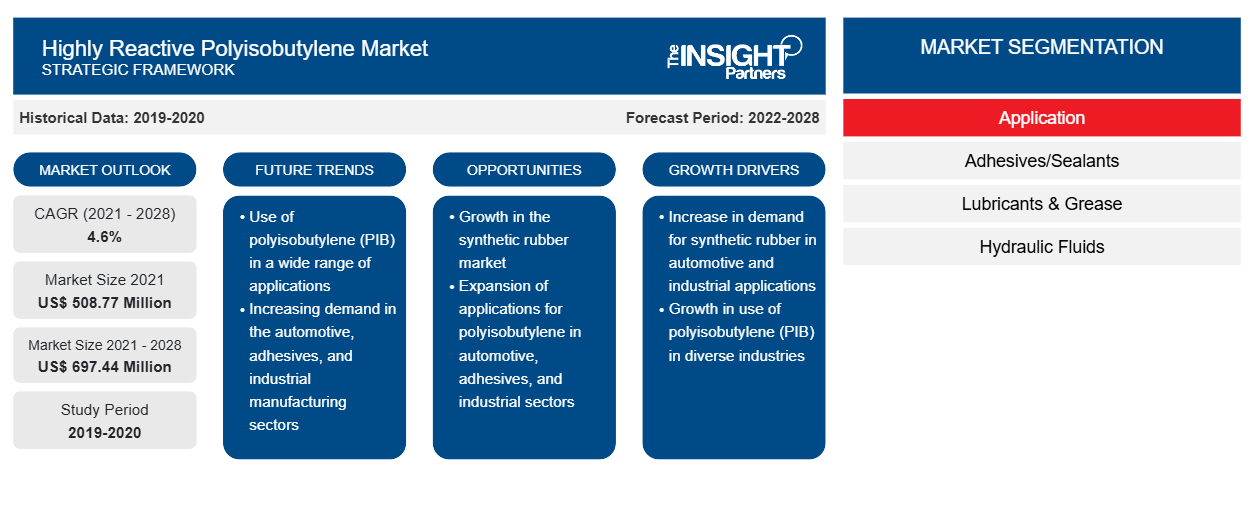Le marché du polyisobutylène hautement réactif devrait atteindre 697,44 millions de dollars américains d'ici 2028, contre 508,77 millions de dollars américains en 2021 ; il devrait croître à un TCAC de 4,6 % de 2021 à 2028.polyisobutylene market is projected to reach US$ 697.44 million by 2028 from US$ 508.77 million in 2021; it is expected to grow at a CAGR of 4.6% from 2021 to 2028.
Le polyisobutylène hautement réactif (HR-PIB) est un intermédiaire important utilisé dans la production d'additifs pour carburants et lubrifiants hautes performances, tels que des dispersants pour huiles moteur ou des détergents pour carburants. Les additifs pour lubrifiants hautes performances permettent de concevoir des moteurs plus économes en carburant.polyisobutylene (HR-PIB) is an important intermediate used in the production of high-performance fuel and lubricant additives, such as dispersants for engine oils or fuel detergents. The high-performance lubricant additives allow for more fuel-efficient engine designs.
En 2020, l'Asie-Pacifique détenait la plus grande part de revenus du marché du polyisobutylène hautement réactifpolyisobutylene market . Le segment des lubrifiants et graisses est le plus grand consommateur de HR-PIB dans la région Asie-Pacifique. La prolifération du secteur automobile dans la région stimule la demande de fluides hydrauliques et de lubrifiants, propulsant ainsi le besoin de HR-PIB. En outre, l'augmentation de l'industrialisation et de la construction en Asie-Pacifique stimule la demande de machines et d'équipements dans les installations de fabrication associées.
Personnalisez ce rapport en fonction de vos besoins
Vous bénéficierez d'une personnalisation gratuite de n'importe quel rapport, y compris de certaines parties de ce rapport, d'une analyse au niveau des pays, d'un pack de données Excel, ainsi que de superbes offres et réductions pour les start-ups et les universités.
-
Obtenez les principales tendances clés du marché de ce rapport.Cet échantillon GRATUIT comprendra une analyse de données, allant des tendances du marché aux estimations et prévisions.
Impact de la pandémie de COVID-19 sur le marché du polyisobutylène hautement réactif
En 2020, diverses industries ont dû ralentir leurs opérations en raison de perturbations dans les chaînes d'approvisionnement causées par la fermeture des frontières nationales et internationales, ce qui a entraîné une faible demande de HR-PIB. La pandémie a provoqué des perturbations dans les processus de fabrication en raison des restrictions imposées par les autorités gouvernementales de divers pays sur les effectifs sur les lieux de travail et les transports, ce qui a rendu difficile pour les employés de se déplacer vers et depuis les lieux de travail. HR-PIB trouve des applications majeures dans la fabrication d'additifs pour carburants et lubrifiants hautes performances. La baisse de la demande de carburant de diverses industries a entravé la consommation d'additifs pour carburants, ce qui a fini par entraver les ventes de HR-PIB. Cependant, alors que les économies ont commencé à relancer leurs activités en 2021, la demande de HR-PIB a également commencé à augmenter progressivement.
Informations sur le marché
Utilisation croissante du HR-PIB dans la production d'additifs pour carburants et lubrifiants hautes performances
Le HR-PIB est un intermédiaire important qui trouve une application dans la production d' is an important intermediate that finds application in the production of high-performance fuel and additifs pour carburants et lubrifiants hautes performances . En raison de sa nature hautement réactive, il est préféré au polyisobutylène conventionnel dans la production d'additifs. La fonction principale des additifs pour lubrifiants est d'améliorer les propriétés de l'huile de base dans différentes conditions de fonctionnement. De plus, les additifs pour lubrifiants hautes performances favorisent des conceptions de moteurs plus économes en carburant. Les dispersants sont des additifs pour lubrifiants qui aident à prévenir la formation de boues, de vernis et d'autres dépôts sur les surfaces critiques. La demande de HR-PIB augmente dans la synthèse industrielle de dispersants pour les huiles moteur automobiles. La présence de bases de fabrication additive solides aux États-Unis, en Europe et en Asie-Pacifique en fait des consommateurs de premier plan de HR-PIB. Par conséquent, l'utilisation croissante de HR-PIB dans la fabrication d'additifs pour carburants et lubrifiants hautes performances stimule la croissance du marché.polyisobutylene in the production of additives. The main function of lubricant additives is to improve the properties of the base stock under different operating conditions. Moreover, high-performance lubricant additives support more fuel-efficient engine designs. Dispersants are lubricant additives that help prevent sludge, varnish, and other deposit formation on critical surfaces. The demand for HR-PIB is growing in the industrial synthesis of dispersants for automotive engine oils. The presence of strong additive manufacturing bases in the US, Europe, and Asia Pacific makes them prime consumers of HR-PIB. Hence, the increasing use of HR-PIB in the manufacturing of high-performance fuel and lubricant additives boosts the market growth.
Informations sur les applications
En fonction des applications, le marché du polyisobutylène hautement réactif a été segmenté en adhésifs/produits d'étanchéité, lubrifiants et graisses, fluides hydrauliques, fluides de travail des métaux et autres. Le segment des lubrifiants et graisses détenait la plus grande part de marché en 2020. Les lubrifiants tels que les huiles moteur, les huiles de transmission, les huiles pour engrenages, les graisses et les huiles pour compresseurs sont très consommés dans les secteurs de l'automobile, de l'aéronautique, de la marine et des machines. Le HR-PIB contribue à améliorer les performances globales des lubrifiants.polyisobutylene market has been segmented into adhesives/sealants, lubricants & grease, hydraulic fluids, metal working fluids, and others. The lubricants & grease segment held the largest market share in 2020. Lubricants such as engine oils, transmission oils, gear oils, greases, and compressor oils are highly consumed in the automotive, aircraft, marine, and machinery industries. HR-PIB helps enhance the overall performance of lubricants.
Français TPC Group ; RB PRODUCTS INC. ; BASF PETRONAS Chemicals Sdn. Bhd ; Shandong Hongrui New Material Technology Co., Ltd ; Daelim Co., Ltd. ; Chevron Corporation ; The Lubrizol Corporation ; KEMAT Polybutenes ; Weifang Binhai Petro-chem Co., Ltd. ; et Nelson Brothers Incorporated comptent parmi les principaux acteurs du marché du polyisobutylène hautement réactif. Les acteurs opérant sur le marché du polyisobutylène hautement réactif se concentrent fortement sur le développement de produits innovants et de haute qualité pour répondre aux exigences des clients. Group; RB PRODUCTS INC.; BASF PETRONAS Chemicals Sdn. Bhd; Shandong Hongrui New Material Technology Co., Ltd; Daelim Co., Ltd.; Chevron Corporation; The Lubrizol Corporation; KEMAT Polybutenes; Weifang Binhai Petro-chem Co., Ltd.; and Nelson Brothers Incorporated are among the key market players in the highly reactive polyisobutylene market. Players operating in the highly reactive polyisobutylene market are highly focused on the development of high-quality and innovative products to meet the customer’s requirements.
Aperçu régional du marché du polyisobutylène hautement réactifPolyisobutylene Market Regional Insights
Les tendances et facteurs régionaux influençant le marché du polyisobutylène hautement réactif tout au long de la période de prévision ont été expliqués en détail par les analystes d’Insight Partners. Cette section traite également des segments et de la géographie du marché du polyisobutylène hautement réactif en Amérique du Nord, en Europe, en Asie-Pacifique, au Moyen-Orient et en Afrique, ainsi qu’en Amérique du Sud et en Amérique centrale.

- Obtenez les données régionales spécifiques au marché du polyisobutylène hautement réactif
Portée du rapport sur le marché du polyisobutylène hautement réactif
| Attribut de rapport | Détails |
|---|---|
| Taille du marché en 2021 | 508,77 millions de dollars américains |
| Taille du marché d'ici 2028 | 697,44 millions de dollars américains |
| Taux de croissance annuel moyen mondial (2021-2028) | 4,6% |
| Données historiques | 2019-2020 |
| Période de prévision | 2022-2028 |
| Segments couverts |
Par application
|
| Régions et pays couverts |
Amérique du Nord
|
| Leaders du marché et profils d'entreprises clés |
|
Densité des acteurs du marché du polyisobutylène hautement réactif : comprendre son impact sur la dynamique commerciale
Le marché du polyisobutylène hautement réactif connaît une croissance rapide, tirée par la demande croissante des utilisateurs finaux en raison de facteurs tels que l'évolution des préférences des consommateurs, les avancées technologiques et une plus grande sensibilisation aux avantages du produit. À mesure que la demande augmente, les entreprises élargissent leurs offres, innovent pour répondre aux besoins des consommateurs et capitalisent sur les tendances émergentes, ce qui alimente davantage la croissance du marché.
La densité des acteurs du marché fait référence à la répartition des entreprises ou des sociétés opérant sur un marché ou un secteur particulier. Elle indique le nombre de concurrents (acteurs du marché) présents sur un marché donné par rapport à sa taille ou à sa valeur marchande totale.
Les principales entreprises opérant sur le marché du polyisobutylène hautement réactif sont :
- Groupe TPC
- PRODUITS RB INC.
- BASF PETRONAS Chemicals Sdn. Bhd
- Shandong Hongrui New Material Technology Co., Ltd
- Daelim Co., Ltd.
Avis de non-responsabilité : les sociétés répertoriées ci-dessus ne sont pas classées dans un ordre particulier.

- Obtenez un aperçu des principaux acteurs du marché du polyisobutylène hautement réactif
Rapports en vedette
- Tendances progressistes dans l'industrie du polyisobutylène hautement réactif pour aider les acteurs à développer des stratégies efficaces à long terme
- Stratégies de croissance commerciale adoptées par les entreprises pour assurer leur croissance sur les marchés développés et en développement
- Analyse quantitative du marché du polyisobutylène hautement réactif de 2019 à 2028
- Estimation de la demande mondiale en HR-PIB
- Analyse des cinq forces de Porter pour illustrer l'efficacité des acheteurs et des fournisseurs opérant dans l'industrie
- Développements récents pour comprendre le scénario concurrentiel du marché
- Tendances et perspectives du marché, et facteurs qui stimulent et freinent la croissance du marché du polyisobutylène hautement réactif
- Aide à la prise de décision en mettant en évidence les stratégies de marché qui sous-tendent l'intérêt commercial
- Taille du marché du polyisobutylène hautement réactif à différents niveaux
- Aperçu détaillé et segmentation du marché, ainsi que de la dynamique de l'industrie HR-PIB
- Taille du marché du polyisobutylène hautement réactif dans diverses régions avec des opportunités de croissance prometteuses
Marché du polyisobutylène hautement réactif
Application
- Adhésifs/Matériaux d'étanchéité
- Lubrifiant et graisse
- Fluides hydrauliques
- Fluides pour le travail des métaux
- Autres
Profils d'entreprise
- Groupe TPC
- PRODUITS RB INC.
- BASF PETRONAS Chemicals Sdn. Bhd
- Shandong Hongrui New Material Technology Co., Ltd
- Daelim Co., Ltd.
- Société Chevron
- La société Lubrizol
- Polybutènes KEMAT
- Weifang Binhai Petro-chem Co., Ltd.
- Société des Frères Nelson
- Analyse historique (2 ans), année de base, prévision (7 ans) avec TCAC
- Analyse PEST et SWOT
- Taille du marché Valeur / Volume - Mondial, Régional, Pays
- Industrie et paysage concurrentiel
- Ensemble de données Excel
Rapports récents
Témoignages
Raison d'acheter
- Prise de décision éclairée
- Compréhension de la dynamique du marché
- Analyse concurrentielle
- Connaissances clients
- Prévisions de marché
- Atténuation des risques
- Planification stratégique
- Justification des investissements
- Identification des marchés émergents
- Amélioration des stratégies marketing
- Amélioration de l'efficacité opérationnelle
- Alignement sur les tendances réglementaires























 Obtenez un échantillon gratuit pour - Marché du polyisobutylène hautement réactif
Obtenez un échantillon gratuit pour - Marché du polyisobutylène hautement réactif